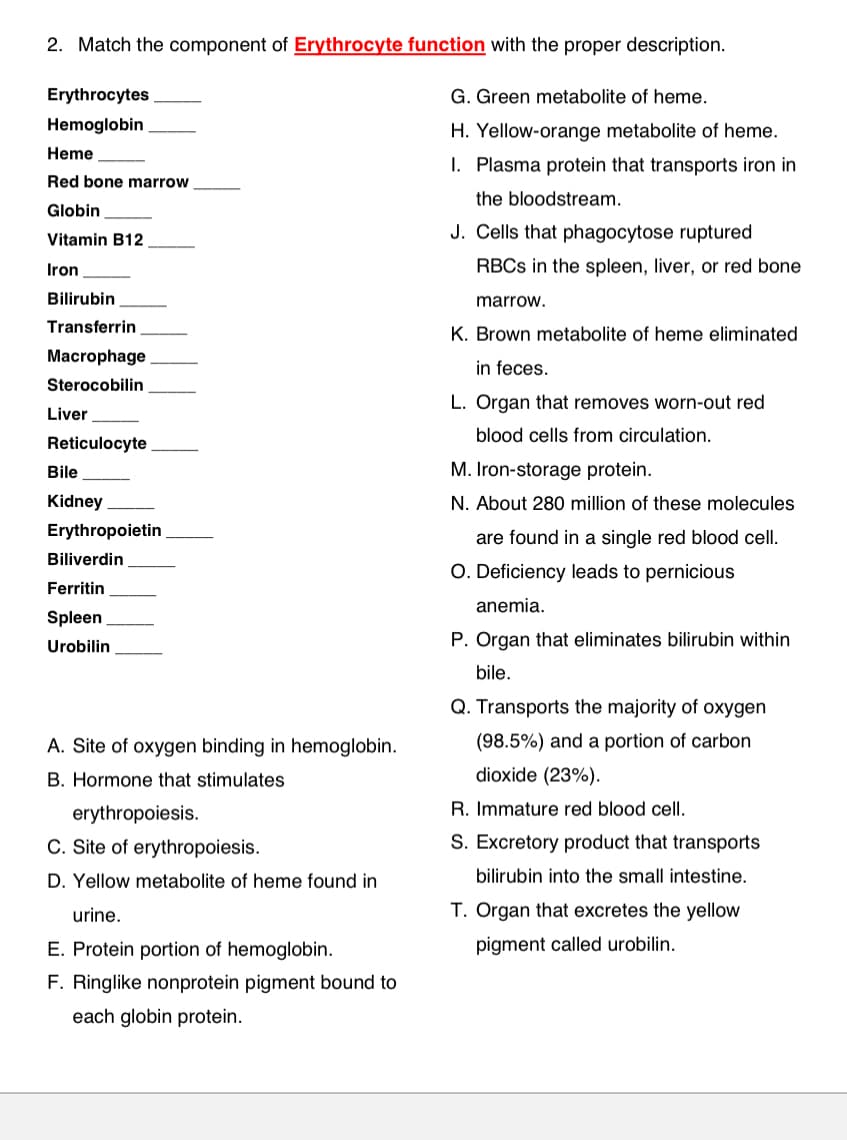2. Match the component of Erythrocyte function with the proper description. Erythrocytes G. Green metabolite of heme. Hemoglobin H. Yellow-orange metabolite of heme. Heme I. Plasma protein that transports iron in Red bone marrow the bloodstream. Globin J. Cells that phagocytose ruptured Vitamin B12 Iron RBCS in the spleen, liver, or red bone Bilirubin marrow. Transferrin K. Brown metabolite of heme eliminated Macrophage in feces. Sterocobilin L. Organ that removes worn-out red Liver blood cells from circulation. Reticulocyte Bile M. Iron-storage protein. Kidney N. About 280 million of these molecules Erythropoietin are found in a single red blood cell. Biliverdin O. Deficiency leads to pernicious Ferritin anemia. Spleen Urobilin P. Organ that eliminates bilirubin within bile. Q. Transports the majority of oxygen A. Site of oxygen binding in hemoglobin. (98.5%) and a portion of carbon B. Hormone that stimulates dioxide (23%). erythropoiesis. R. Immature red blood cell. C. Site of erythropoiesis. S. Excretory product that transports D. Yellow metabolite of heme found in bilirubin into the small intestine. urine. T. Organ that excretes the yellow E. Protein portion of hemoglobin. pigment called urobilin. F. Ringlike nonprotein pigment bound to each globin protein.
2. Match the component of Erythrocyte function with the proper description. Erythrocytes G. Green metabolite of heme. Hemoglobin H. Yellow-orange metabolite of heme. Heme I. Plasma protein that transports iron in Red bone marrow the bloodstream. Globin J. Cells that phagocytose ruptured Vitamin B12 Iron RBCS in the spleen, liver, or red bone Bilirubin marrow. Transferrin K. Brown metabolite of heme eliminated Macrophage in feces. Sterocobilin L. Organ that removes worn-out red Liver blood cells from circulation. Reticulocyte Bile M. Iron-storage protein. Kidney N. About 280 million of these molecules Erythropoietin are found in a single red blood cell. Biliverdin O. Deficiency leads to pernicious Ferritin anemia. Spleen Urobilin P. Organ that eliminates bilirubin within bile. Q. Transports the majority of oxygen A. Site of oxygen binding in hemoglobin. (98.5%) and a portion of carbon B. Hormone that stimulates dioxide (23%). erythropoiesis. R. Immature red blood cell. C. Site of erythropoiesis. S. Excretory product that transports D. Yellow metabolite of heme found in bilirubin into the small intestine. urine. T. Organ that excretes the yellow E. Protein portion of hemoglobin. pigment called urobilin. F. Ringlike nonprotein pigment bound to each globin protein.
Biology: The Dynamic Science (MindTap Course List)
4th Edition
ISBN:9781305389892
Author:Peter J. Russell, Paul E. Hertz, Beverly McMillan
Publisher:Peter J. Russell, Paul E. Hertz, Beverly McMillan
Chapter44: The Circulatory System
Section: Chapter Questions
Problem 3TYK
Related questions
Question

Transcribed Image Text:2. Match the component of Erythrocyte function with the proper description.
Erythrocytes
G. Green metabolite of heme.
Hemoglobin
H. Yellow-orange metabolite of heme.
Heme
I. Plasma protein that transports iron in
Red bone marrow
the bloodstream.
Globin
Vitamin B12
J. Cells that phagocytose ruptured
Iron
RBCS in the spleen, liver, or red bone
Bilirubin
marrow.
Transferrin
K. Brown metabolite of heme eliminated
Macrophage
in feces.
Sterocobilin
L. Organ that removes worn-out red
Liver
blood cells from circulation.
Reticulocyte
Bile
M. Iron-storage protein.
Kidney
N. About 280 million of these molecules
Erythropoietin
are found in a single red blood cell.
Biliverdin
O. Deficiency leads to pernicious
Ferritin
anemia.
Spleen
Urobilin
P. Organ that eliminates bilirubin within
bile.
Q. Transports the majority of oxygen
A. Site of oxygen binding in hemoglobin.
(98.5%) and a portion of carbon
B. Hormone that stimulates
dioxide (23%).
erythropoiesis.
R. Immature red blood cell.
C. Site of erythropoiesis.
S. Excretory product that transports
D. Yellow metabolite of heme found in
bilirubin into the small intestine.
urine.
T. Organ that excretes the yellow
E. Protein portion of hemoglobin.
pigment called urobilin.
F. Ringlike nonprotein pigment bound to
each globin protein.
Expert Solution
This question has been solved!
Explore an expertly crafted, step-by-step solution for a thorough understanding of key concepts.
This is a popular solution!
Trending now
This is a popular solution!
Step by step
Solved in 2 steps

Knowledge Booster
Learn more about
Need a deep-dive on the concept behind this application? Look no further. Learn more about this topic, biology and related others by exploring similar questions and additional content below.Recommended textbooks for you

Biology: The Dynamic Science (MindTap Course List)
Biology
ISBN:
9781305389892
Author:
Peter J. Russell, Paul E. Hertz, Beverly McMillan
Publisher:
Cengage Learning


Biology: The Unity and Diversity of Life (MindTap…
Biology
ISBN:
9781337408332
Author:
Cecie Starr, Ralph Taggart, Christine Evers, Lisa Starr
Publisher:
Cengage Learning

Biology: The Dynamic Science (MindTap Course List)
Biology
ISBN:
9781305389892
Author:
Peter J. Russell, Paul E. Hertz, Beverly McMillan
Publisher:
Cengage Learning


Biology: The Unity and Diversity of Life (MindTap…
Biology
ISBN:
9781337408332
Author:
Cecie Starr, Ralph Taggart, Christine Evers, Lisa Starr
Publisher:
Cengage Learning

Biology: The Unity and Diversity of Life (MindTap…
Biology
ISBN:
9781305073951
Author:
Cecie Starr, Ralph Taggart, Christine Evers, Lisa Starr
Publisher:
Cengage Learning

Human Biology (MindTap Course List)
Biology
ISBN:
9781305112100
Author:
Cecie Starr, Beverly McMillan
Publisher:
Cengage Learning

Anatomy & Physiology
Biology
ISBN:
9781938168130
Author:
Kelly A. Young, James A. Wise, Peter DeSaix, Dean H. Kruse, Brandon Poe, Eddie Johnson, Jody E. Johnson, Oksana Korol, J. Gordon Betts, Mark Womble
Publisher:
OpenStax College